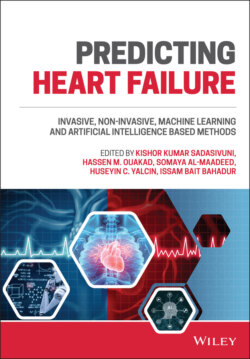Читать книгу Predicting Heart Failure - Группа авторов - Страница 65
2.3.8 Blood Pressure and Pulse
ОглавлениеThe amount of force used by the heart to pump blood across the body is referred to as blood pressure; in other words, the pressure generated when the heart pumps blood into the circulatory system. Blood pressure is measured using a sphygmomanometer or blood pressure monitor in millimeters of mercury unit (mmHg). There will be two components for each reading of blood pressure, the systolic and diastolic pressures. The force exerted on the walls of arteries by the heart during systole is called systolic pressure. The systole is a short span where the ventricles of the heart are contracted, and it happens in between the first and second heart sound. Diastolic pressure is the force exerted on the walls of arteries between the beats. Generally, blood pressure levels between 120 and 80 mmHg are considered normal. Blood pressure level measurement has significant importance in the heart disease examination procedure. Several studies have found that high blood pressure levels have a clear link with the risk of strokes as well heart diseases in individuals irrespective of their ages [8]. However, a study [9] conducted in different age groups of the Framingham heart study participants observed that in individuals aged less than 50 the diastolic blood pressure levels are a clear indicator for predicting heart disease. On the other hand, systolic pressure levels along with pulse pressure levels are the clear predictor of heart diseases in individuals over 50 years old.
The heart rate, or the cumulative number of times the heart beats in a minute, is referred to as pulse. If the person is resting, 60–100 beats per minute are considered natural. The heart rate can elevate up to 150 if the person is involved in any highly vigorous activity. If the resting heart rate of an individual is less than 60, then it is called bradycardia and, if it is greater than 100/120, then it is called tachycardia. Bradycardia is often linked with underlying heart diseases such as heart failure. Similarly, tachycardia can be an early symptom of heart failure or stroke.
